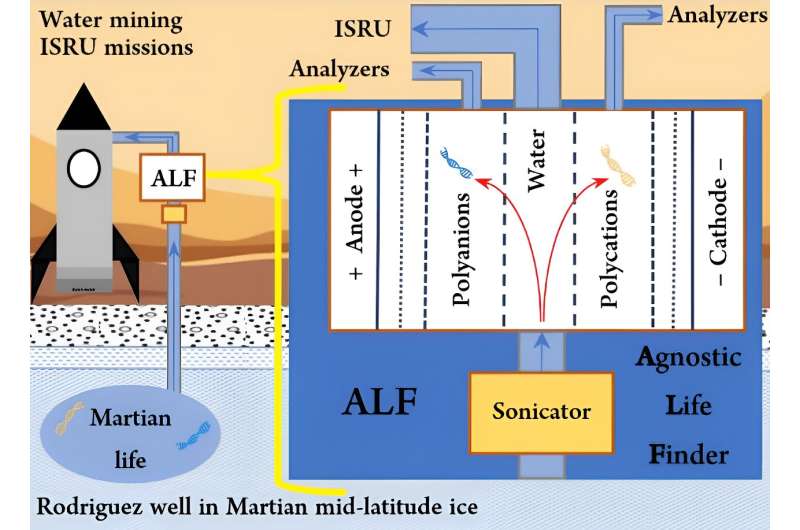This article has been reviewed according to Science X's editorial process and policies. Editors have highlighted the following attributes while ensuring the content's credibility:
fact-checked
trusted source
proofread
Add-on system in Mars water mining operations will screen for introduced and alien life

As noted at NASA's 2019 Carlsbad Conference, we have good reason to think that life could have started on Mars using the same geo-organic chemistry that started life on Earth. If Martian life persists today on Mars, it may be in near-surface ice, low elevations, and caves, all with transient liquid brines, environments that today on Earth host microbial life. Martian life would likely use informational polymers (like DNA); Darwinian evolution requires these, and Darwinian evolution is the only way matter can organize to give life.
While Martian "DNA" may differ (possibly radically) in its chemistry from Terran DNA, the "Polyelectrolyte Theory of the Gene" limits the universe of possible alien DNA structures. Those structures ensure that Martian DNA can be concentrated from Martian water, even if very highly diluted, and even if Martian "DNA" differs from Earth DNA.
On Mars as it exists today, information polymers cannot be generated without life (unlike other less reliable biosignatures such as methane), ensuring that life will not be "detected" if it is not present (the "false positive problem"). Nevertheless, as noted by Rummel and Conley, "the Mars community is not convinced that a mission to attempt detection of extant Martian life has a high priority."
Thus, NASA's current flagship mission to Mars, derived from its 2012 Decadal Survey, involves pedestrian collection of old dry rocks to be cached, eventually to be returned to Earth to study for evidence of past life.
The purpose of this NIAC project is to change this view, and to do so before human arrival planned by NASA, the Chinese National Space Agency, and SpaceX, "by 2040," "in 2033," and "before 2030," according to their respective statements. Human arrival will undoubtedly complicate the search for indigenous Martian life. Thus, from an astrobiological perspective, these planned crewed missions to Mars put a very strict deadline on the search for life on a pristine Mars.
However, crewed missions also offer an opportunity that we will exploit. Crewed missions to Mars will use materials found on Mars itself, "in situ," in particular, near surface water ice. Propellant (methane and oxygen) will be generated from that water and atmospheric carbon dioxide for the return trip back to Earth. That water ice will be mined on the scale of tens to hundreds of tons.
Further, to maximize the likelihood of safe return of the crew to Earth, robotic operations that mine tons of near surface water-ice will be in place before the first human astronauts arrive. Thus, water mined in preparation for human arrival is correctly seen as an extremely large-scale astrobiological sample, far larger than dry cached rocks.
As the mined water-ice is delivered with dust that, through dust storms, survey the entire accessible surface, this humongous sample will effectively enable a highly sensitive survey of the entire accessible Mars surface for life. This NIAC project will provide an "agnostic life finding" (ALF) system capable of extracting genetic polymers (DNA or alien) from these large ISRU water samples. ALF is agnostic because it exploits what synthetic biology taught us about the limited kinds of Darwinian genetic molecules. ALF also offers tools to partly analyze the polyelectrolytes in situ.
As an add-on system, ALF creates a negligible additional burden (regarding mass and energy consumption) compared to the investment in the water mining operation at this scale. Although small and low cost, this instrument will allow science to place a severe lower limit on the amount of biosphere on the accessible Martian surface. And it will do so before Homo sapiens becomes a multiplanetary species.
And "multiplanetary" is the correct term. This add-on ALF system can be used on all celestial bodies where water will be mined to search for and analyze life, indigenous or introduced, Earth-like or alien. This includes Europa, Enceladus, the moon, and exotic locales on Earth.
Provided by NASA





















